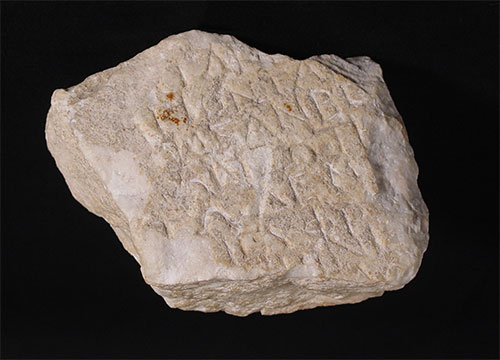Inscribed Hellenistic or Roman Marble Manumission Stele Fragment
1914.03.0008
Detailed Images
Basic Information
| Artifact Identification | Inscribed Hellenistic or Roman Marble Manumission Stele Fragment (1914.03.0008) |
|---|---|
| Classification/ Nomenclature |
|
| Artist/Maker | None |
| Geographic Location | |
| Period/Date | Hellenistic or Roman Empire, ca. 200 BCE - 100 CE |
| Culture | Hellenistic or Roman |
| Location | On Exhibitin the Ancient Mediterranean exhibit |
Physical Analysis
| Dimension 1 (Length) | 13.0 cm |
|---|---|
| Dimension 2 (Width) | 9.0 cm |
| Dimension 3 (Depth) | 4.6 cm |
| Weight | 977 g |
| Measuring Remarks | None |
| Materials | Stone--Marble |
| Manufacturing Processes | Cutting |
| Munsell Color Information | Light Yellowish Brown (10YR 7/4) -ns |
Research Remarks
| Published Description | Opisthographic marble stele, Kalapodi in Locris, unpublished. J. Bodel and S. Tracy, eds. Greek and Roman Inscriptions in the U.S.A., American Academy in Rome, 1997. A fragment of a stele of white marble inscribed on both sides; found in a stable in the village. One side (a) has been prepared for an inscription, and the lines and letters are regular; the other side (b) is slightly convex and somewhat rough, the letters are less regular and the lines somewhat crowded. Probably inscription (b) was added after (a) had already been set up. We have here probably manumission edicts, as may be inferred from the mention of the god Apollo on side (b) lines 6–7, from the endings “–to” in (a) 5 and (b) 5, which can hardly be anything but the third person of the imparative so common in such decrees, and finally from the certain restoration “[mar]tures, in (b) 6. The word “nomon” on (b) 2 also agree well with this interpretation. But the fragment is very small and the length of the lines unknown. William Abbott Oldfather, "Inscriptions from Locris," American Journal of Archaeology, (19) 1915, 334–35, no. 16. |
|---|---|
| Description | Both sides are inscribed in Greek with eight lines of writing preserved on each side and from two to seven letters legible on each line. |
| Comparanda | N/A |
| Bibliography | "Appointment with Apollo," Heritage Magazine. Oct. 1988, pp. 4-5. Bodel, John, & Stephen Tracy, eds. Greek and Latin Inscriptions in the USA: A Checklist. Rome: American Academy, 1997. Archaeological Reports, 29 (1982-83): 32-34. Fisher, N. R. E. 2001 [1993] Slavery in Classical Greece. London. Oldfather, W. A. "Inscriptions from Locris," American Journal of Archaeology, 19 (1915): 320-339. Rainer C. S. Felsch (Ed.), 1996 and 2007. Kalapodi I and II. Mainz am Rhein. Taxing Freedom in Thessalian Manumission Inscriptions. Mnemosyne supplement 361. Leiden: 2013. Zelnick-Abramowitz, Rachel. Not Wholly Free: The Concept of Manumission and the Status of Manumitted Slaves in the Ancient Greek World. Leiden: 2005. |
Artifact History
| Archaeological Data | Near the village of Kalapodi is the Sanctuary of Artemis Elaphebolos and Apollo located five kilometers north of the ancient polis of Hyamopolis in Opuntian Lokris (Eastern Lokris). Excavations by the German Archaeological Institute have continued there from 1973–1982 under Reiner C. S. Felsch and from 2004– under Wolf-Dietrich Niemeier. The sanctuary is mentioned in Pausanias 10.25.4. Along with this ancient reference, the findspot of the Spurlock inscription is cited as part of the evidence to identify the sanctuary.--Professor James Dengate |
|---|---|
| Credit Line/Dedication | Classical Museum Purchase |
| Reproduction | no |
| Reproduction Information | N/A |
